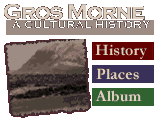
 Winterhouse Brook: Where early settlers in the area would live in the winter.
Winterhouse Brook: Where early settlers in the area would live in the winter.
 The strange looking lobster made the crossover from fish bait to human
food in the late 1800's. With it, came many arguments and debates. Even the Vatican
became involved, because if lobster was deemed a fish, it could be eaten on Friday, otherwise
it could not!
The strange looking lobster made the crossover from fish bait to human
food in the late 1800's. With it, came many arguments and debates. Even the Vatican
became involved, because if lobster was deemed a fish, it could be eaten on Friday, otherwise
it could not!

On the northern side of Bonne Bay is Norris Point, named after one of the first settlers, Neddy Norris. It is reported that an English captain arriving there in the late 1700's met up with this man, "dressed as a Red Indian" who was interested in trading salmon. Other early settlers include William Salmon and Henry Creasy.
On the southern side of Bonne Bay, an English merchant, Joseph Bird, established a trading post in Woody Point around 1800. This was the first of many trading posts established by Bird around the island. These posts encouraged settlement along the coast. The Woody Point venture was particularly known for salmon trading, especially in the early years. Later, fur trading became quite significant. Local familes would catch animals for fur, and traded with the merchant for supplies, foodstuffs and clothing. Labourers, servants and apprentices were brought from southwestern England during the summer to support the trading post. Many of them eventually settled in the area during the third quarter of the 1800's.
Fishing was a way of life for most of the settlers on this coast. At that time, people fished all year round. During the winter months, English settlers caught herring by putting nets under the ice. In the spring, this herring was sold to the French fishermen to be used for bait. In the summer, salmon was caught and traded with the merchants.As a result of the treaty between the English and French on the use of this coast, two distinct areas developed. The British residents who lived in the inner bays, using resources such as fur, timber, soil, salmon and herring; and the French fishermen located on islands in the Gulf, who fished for cod. Although settlement was prohibited, the French didn't complain, since it was advantageous for them to have a source of bait when they came to fish for cod in the spring. Settlers took advantage of this situation as well, by trading illegally with the French to avoid the British import duties. Settlement was still slow; only 35 people lived in the park area in 1835. In 1869, there were 430 settlers and by 1884, the population had grown to 1495 settlers.
Families settled in areas within close proximity to the fishing grounds. Most of the settlers built their own houses, fishing sheds, drying flakes and wharves. Many kept small vegetable gardens for potatoes, carrots, turnip and cabbage. They also raised sheep for wool and meat. Later, oxen were brought in for heavy farmwork and to work in the woods. Some families kept ponies, but they were mostly a luxury item.
Isolation was a part of life for the early settlers along this coast. In summer, people could get around by boat. In the winter, the only way to get from community to community was to traverse small footpaths. People either walked or took dog sleighs. One of the biggest forces in keeping people in isolation was the French shore treaty. Because people were not officially allowed to settle on the French shore, the communities were not recognized by the government. There were no schools, medical services, policing, or any other legal or social framework for community growth. This left the settlers and French in an uneasy situation.
Many families on this coast practised a form of winter migration that mirrored that of the early native inhabitants of the province. This was called "winter-housing", "shifting", or "going up in tilts". After the fishing season had ended, families would move inland to take sheltered wooded areas. This way, they were protected from the harsh winds of the coast, closer to hunting and trapping areas and wood was readily available for firewood. The structures they lived in during these winter months were called tilts or winterhouses. These were flimsy structures, with a hole in a roof used as a vent for smoke. There were no windows. As time passed, building methods became more sophisticated allowing more comfortable accommodation. Summer life was much better, however, and everyone eagerly awaited the return to the water in spring. With the introduction of schooling and other services, and better insulation for a family's main house in the community, there were less reasons to use winter-houses, and the practise died out in the early part of the 1900's. This tradition still survives on in the names of various communities in Newfoundland, in particular, Winterhouse Brook, near Woody Point.
In the park today, some families still practise seasonal migration. Certain communities such as Baker's Brook, Lobster Cove, Green Point, Hickeys and Old House Rocks serve as small summer fishing communites once children finish school in June. After fishing is over for the summer, the small cabins are closed up and everyone moves back into town. Many families also keep small cabins inland and use them during the winter months, but as part of winter recreation and snowmobiling trips, and not as a means of survival.
The first substantial settlement to develop in the park area was Woody Point. Previously a trading post, Woody Point became a major economic center during the latter half of the 1800's. Bird & Company was bought out by a company from the island of Jersey, and the community became known as the Jersey Room. By 1872, Woody Point had a post office, with the post mark Bonne Bay, as it served the whole area. Some people still refer to Woody Point as Bonne Bay.
During this time of relative prosperity, merchants increased in the area. Fishermen visited the merchants in the spring to get supplies on credit. In the summer, they fished and dried their catches. In the autumn, they would return to the merchants and settle their accounts. Since the merchants set both the price of their merchandise and the price of the fishermen's catch, the fishermen often remain indebted to the merchants year after year.
During the last half of the 1800's, the fishery was often in an unpredictable state. After the decline in the salmon and cod fisheries, the herring fishery became the staple source of income for most families in Bonne Bay. After 1870, herring stock dropped sharply. At the time, herring migrations were poorly understood, but overfishing seems to have had a larger role in the decline of the herring stock.
Fortunately a new resource came along to allow families to survive on this coast: lobsters. Lobsters had become a fashionable dietary item, especially in New England, and there was high demand. Previously, the "crawlers" were used as bait by the French, since they couldn't be preserved. With the advent of canning, lobsters could be preserved and shipped to faraway markets. All along the west coast, small lobster factories sprang up, from 12 in 1887, to 76 only four years later.
With the boom in the lobster fishery came more settlers and added problems. The settlements were becoming overcrowded, and the few services that did exist were running at full capacity. Conflict increased between the French and English as the lobster fishery grew in popularity. French claimed that if lobster was a fish, then it fell under French jurisdiction, and they had the right to catch the species. If lobster was not a fish, then the resource could be exploited by the English settlers. The conflict was settled in 1904, when France accepted a cash payment and a settlement of imperial disputes in Africa as an exchange for the French Shore. With this, the entire island of Newfoundland came under British rule, and the west coast settlements were legally recognized. The west coast was still considered to be quite backward by most standards of the early twentieth century. Without legal recognition, communities had been slow to grow, and did not have many services like schools, churches and courts.
| << previous | next >> |